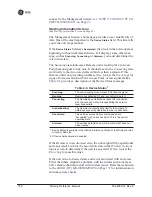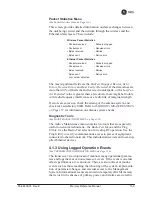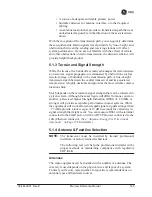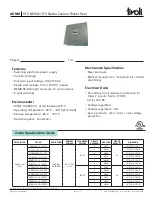
05-4446A01, Rev. E
Mercury Reference Manual
165
• A source of adequate and stable primary power
• Suitable entrances for antenna, interface, or other required
cabling
• An antenna location that provides a transmission path that is as
unobstructed as possible in the direction of the associated sta-
tion
(
s
)
With the exception of the transmission path, you can quickly determine
these requirements. Radio signals travel primarily by line-of-sight, and
obstructions between the sending and receiving stations will affect
system performance. If you are not familiar with the effects of terrain
and other obstructions on radio transmission, the discussion below will
provide helpful background.
5.1.3 Terrain and Signal Strength
While the license-free bands offers many advantages for data transmis-
sion services, signal propagation is attenuated by obstructions such as
terrain, foliage, or buildings in the transmission path. A line-of-sight
transmission path between the central transceiver and its associated
remote site
(
s
)
is highly desirable and provides the most reliable commu-
nications link.
Much depends on the minimum signal strength that can be tolerated in
a given system. Although the exact figure will differ from one system to
another, a Received Signal Strength Indication (RSSI) of –80 dBm or
stronger will provide acceptable performance in most systems. While
the equipment will work at lower-strength signals, signals stronger than
– 77 dBm provide a fade margin of 15 dB to account for variations in
signal strength that might occur. You can measure RSSI with a terminal
connected to the
COM1
port, or with an HTTP browser connected to the
LAN
(Ethernet) connector. (
See “Antenna Aiming (For Directional
Antennas)” on Page 158
for details.)
5.1.4 Antenna & Feedline Selection
NOTE:
The transceiver must be installed by trained professional
installers, or factory trained technicians.
The following text will help the professional installer in the
proper methods of maintaining compliance with regulatory
ERP limits.
Antennas
The radio equipment can be installed with a number of antennas. The
exact style used depends on the physical size and layout of a system.
Contact your factory representative for specific recommendations on
antenna types and hardware sources.
Summary of Contents for Mercury 3650
Page 9: ...viii Mercury Reference Manual 05 4446A01 Rev E ...
Page 11: ...2 Mercury Reference Manual 05 4446A01 Rev E ...
Page 31: ...22 Mercury Reference Manual 05 4446A01 Rev E ...
Page 155: ...146 Mercury Reference Manual 05 4446A01 Rev E ...
Page 157: ...148 Mercury Reference Manual 05 4446A01 Rev E ...
Page 171: ...162 Mercury Reference Manual 05 4446A01 Rev E ...
Page 185: ...176 Mercury Reference Manual 05 4446A01 Rev E ...
Page 201: ...192 Mercury Reference Manual 05 4446A01 Rev E ...
















































